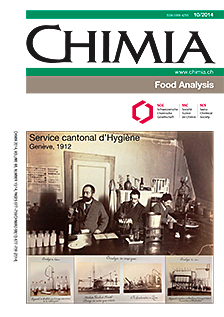Development and in-house Validation of a Rapid LC-MS/MS Method for the Semi-quantification of Eleven Mycotoxins in Maize Samples
DOI:
https://doi.org/10.2533/chimia.2014.716Keywords:
Cereals, Lc-ms/ms, Maize, MycotoxinsAbstract
The aim of this study is a current trend in chemical food safety control to increase monitoring of the co-occurrence of mycotoxins. Unsanitary conditions during harvesting, drying, packing and storage in production and processing of cereals can effect mycotoxin contamination. A method was developed for the simultaneous determination of 11 mycotoxins: deoxynivalenol, aflatoxins B1, B2, G1 and G2, ochratoxin A, fumonisins B1 and B2, zearalenone, and toxins T-2 and HT-2, allowing confirmation of their presence in maize samples as well as their identification and semi-quantification. The mycotoxins are extracted with a mixture of methanol/water, diluted with water and 0.1% formic acid and then analyzed by LC-HESI-MS/MS in a single 12 min run in positive mode. Multiple reaction monitoring mode (MRM) is applied by using two abundant fragments for each mycotoxin. Matrix effects are compensated using external matrix-matched calibration curves. Recoveries, calculated by spiking blank maize samples, ranging from 95.2% to 113.4%, were in accordance with the performance criteria required by the European Commission and intraday reproducibility ranged from 4.2% to 13.2%. Proficiency test materials and reference materials were analyzed to assess the accuracy of the method with satisfying results for the 11 mycotoxins. The method was used for monitoring of maize samples on sale in Switzerland.Downloads
Published
2014-10-29
How to Cite
[1]
X. Boutsiadou-Theurillat, P. Meier, C. Richard, Chimia 2014, 68, 716, DOI: 10.2533/chimia.2014.716.
Issue
Section
Scientific Articles
License
Copyright (c) 2014 Swiss Chemical Society

This work is licensed under a Creative Commons Attribution-NonCommercial 4.0 International License.







